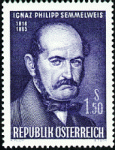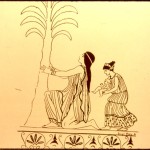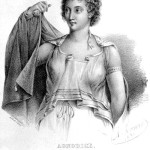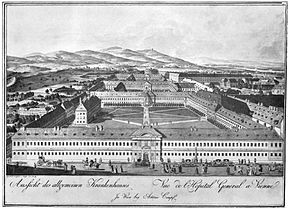Short Cut ~ Read all two hundred years of quotes (organized by each year into 35 sets) in one continuous document.
For readers who prefer smaller bits, the different 35 yearly entries will be divided into sections, and post each day during the month of April.
However you make yourself familiar with this material, it is quite an eye-opener. Descriptions of the dangers of haste associated with the “modern” physician-obstetrican’s practice, were made to the late 1920s and early 1930s. It’s obvious the very same explanations/excuses are being used today to explain the frequent use of Pitocin to augment labor and our high CS rate. As the French put it so eloquently:
“The more things change, the more they stay the same.”
Historical and contemporary comments by physicians about midwives 1820 to 2014:
Day 1: Introduction and 1820 quote in Boston journal
The following historical and contemporary quotes by were made by doctors about midwives over the course of the last 2 centuries on a topic referred they referred to as “the midwife problem”.
Within the medical community there were, and continue to be wide differences and polar opposite opinions on the value (vs. danger) of physiologic management of normal childbirth and proper role of professional midwifery care for healthy women with normal pregnancies.
While physicians fiercely debated the ‘midwife problem’ over the last 2 centuries, midwives and the childbearing women who used their services, were not invited to participate in these important discussions.
I hope these dramatic, conflicting, and frequently disparaging comments among members of the medical profession will provide a helpful perspective to better understand the political tension and on-going controversies between medicine and midwifery.
I describe this as the last and most important UNTOLD story of the 20th century.
For many centuries the controversy within the medical profession over what they called “female practitioners of midwifery” simmered on the back-burner. It finally burst into flames in the US in the early 20th century, and has been going on ever since. This amazingly upsetting story is still a very long way from being over.
1820 ~”Remarks on the Employment of Females as Practitioners in *Midwifery; Published Cummings & Hilliard – Boston, 1820
….where midwifery has been in the hands of women, they have only practiced among the poorer and lower classes of people; the richer .. preferring to employ physicians, and this has been the reason why it has not become universal…
… but if it is again introduced among the rich and influential, it will become fashionable; it will be considered as indelicate and vulgar to employ as physician, and the custom will become general.
It is sufficiently obvious if the employment of female practitioners becomes fashionable, that it will create a fastidious nicety of feeling, which will make it be thought indelicate to suffer the attendance of a physician…
| 5 |
| 8 |
| 9 |
| 7 |
| 7 |
| 8 |
| 8 |
1840-1847 ~ Dr Ignaz Semmelweis, physician-scientist who devoted himself to ending the pandemics of childbirth septicemia in 19th century Austria
A modern-day biography described Dr Semmelweis as:
“…one of the most prominent medical figures of his time. His discovery concerning the aetiology and prevention of puerperal fever was a brilliant example of fact-finding, meaningful statistical analysis, and keen inductive reasoning.
The highly successful prophylactic hand washings made him a pioneer in antisepsis during the pre-bacteriological era {before disposable exam gloves} and in spite of deliberate opposition and uninformed resistance {from other doctors}.”
As a medical student and later as a professor of obstetrics, he worked in the lying-in wards of the world’s largest and most prestigious general hospital — the Allgemeines Krankenhaus in Vienna. In the 1840s, the maternity department housed hundreds of patients at a time, and delivered more than 3,000 babies a year. As was the custom, maternity patients stayed in the hospital for an entire month after the birth, laying around in their beds and breastfeeding their new babies (hence the concept of “lying-in wards”).
Decades before Pasteur and Lister were able to scientifically prove that bacteria caused infectious disease, Semmelweis scientifically established in 1847 that puerperal sepsis or “childbirth fever” in hospitalized maternity patient was a contagious infection spread primarily by medical students and their professors of obstetrics.
Dr. Semmelweis identified the causative factors, saying that:
…. puerperal fever is caused by the examining physician himself, by the manual introduction of cadaveric particles into bruised genitalia.
After performing autopsies on maternity patients who died the day before, med students and their professors unknowingly carried deadly germs on their hands and clothes from the hospital’s morgue to the vaginas of healthy patients in its labor wards.
In Division One, the medical school’s teaching facility for clinical training of doctors, new delivered mothers died from sepsis at an average of two a day. This was a two-to-four fold increase in MMR when compared to births in the “Second Division”, which was a teaching ward run by midwives to train midwifery students. The education of midwives did not include dissecting cadavers or performing autopsies.
Having exposed the iatrogenic nature of puerperal sepsis, Dr. Semmelweis went on to develop effective methods to stop the cycle of contagion between the medical staff and their labor patients, which in turn caused more disease and more deaths. The answer started with hand washing in chlorinated lime water (i.e. bleach).
Semmelweis met with an unfortunate and early death at the age of 47 — just 21 years after starting medical school. He went more than a little crazy when he couldn’t get his professional colleagues to acknowledge the nature of the problem, or use the simple measures (hand washing in chlorinated lime water) that prevented the spread of this fatal disease.
In his own words Dr. Semmelweis concluded that:
Puerperal fever is caused by conveyance to the pregnant woman of putrid particles derived from living organisms, through the agency of the examining fingers, consequently must I confession that God only knows the number of women whom I have consigned prematurely to the grave.
~ The Allgemeines Krankenhaus ~
Poorhouse and hospital extraordinaire
Vienna’s world-famous general hospital (the Allgemeines Krankenhaus or AKH) was a huge medical complex that occupied a whole city block and at that time was the largest, most comprehensive medical facility anywhere in the world.
Like the famous Hotel Dieu in Paris, the AKH was an icon of the original concept of a ‘hospital’ as a place of hospitality for the poor and homeless. Hospital care had little to do with medical cures, everything to do with a dry bed and regular meals. But soon after being founded, the AKH became part of the University of Vienna’s medical school. Its high patient census provided a bottomless pit of patients to be used as ‘teaching material’ and for the clinical training of medical students from all over Europe. In return for this kind of free medical care, all its patients, including women in labor, had to let themselves be used teaching cases and clinical material.
Day 2 ~ Quote from 1881 to 1899, including Edinburgh Obstetrical Society on why menstruating nurses are unfit to provide care to childbearing women (1881)
Introducing Dr J Whitridge Williams, famous author of Williams’ Obstetrics, founding father of academic obstetrics in the United States and developer of the combined disciplines of obstetrics and gynecology into a new surgical specialty — his famou quote “man-midwives” and the bitter rivalry between obstetrics as a tradition medical discipline and gynecology as a surgical specialty





